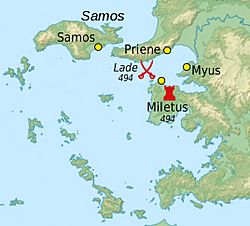Battle of Lade facts for kids
Quick facts for kids Battle of Lade |
|||||||
|---|---|---|---|---|---|---|---|
| Part of Ionian Revolt & Greco-Persian Wars | |||||||
 Map of Lade, Miletus, and the Mycale peninsula. |
|||||||
|
|||||||
| Belligerents | |||||||
| Ionia | Persian Empire | ||||||
| Commanders and leaders | |||||||
| Dionysius of Phocaea | Datis (?) | ||||||
| Strength | |||||||
| 353 ships (Herodotus) | 600 ships (Herodotus) | ||||||
| Casualties and losses | |||||||
| 246 ships | 57 ships | ||||||
The Battle of Lade was a big sea battle that happened in 494 BC. It was fought near the island of Lade, off the coast of Miletus. This battle was between a group of Ionian cities (who were Greek people living in what is now Turkey) and the powerful Persian Empire. The Persian Empire was led by Darius the Great.
The Battle of Lade was a very important part of the Ionian Revolt, which was when the Ionian Greeks tried to break free from Persian rule. The Persians won this battle, which helped them end the revolt and take control of the Ionian cities again.
Contents
What Was the Ionian Revolt?
The Ionian Revolt was a major uprising by several Greek cities in Ionia against the Persian Empire. These cities were located on the western coast of Anatolia (modern-day Turkey). They had been conquered by the Persians earlier.
The Ionian Greeks were used to governing themselves. They didn't like being ruled by the Persians, who often put their own leaders in charge of the cities. The revolt began in 499 BC and lasted for five years.
Why Was Lade Important?
The city of Miletus was the main center of the Ionian Revolt. It was a very important and wealthy Greek city. The Persians decided to attack Miletus to crush the rebellion.
To do this, they needed to control the sea around Miletus. The island of Lade was right next to Miletus, making it a key location for a naval battle.
The Two Sides
The Ionian Greeks gathered a large fleet of ships from different cities. They had 353 ships in total, according to the ancient historian Herodotus. These ships were mostly triremes, which were fast warships with three rows of oars.
The Persian Empire had an even larger fleet. They had 600 ships, also mostly triremes. Their fleet included ships from different parts of their empire, like Phoenicia, Egypt, and Cyprus.
The Battle Unfolds
Before the battle, the Persian commanders tried to get some of the Ionian cities to switch sides. They sent messages promising good treatment if they left the revolt. Some cities, like the people from Samos, were tempted.
The Ionian fleet was led by a skilled commander named Dionysius of Phocaea. He tried to train the Greek sailors to work together better. However, some of the Ionian crews became tired of the strict training.
During the battle, the ships from Samos suddenly left the fight. This caused confusion and weakened the Ionian forces. Other ships also fled, and the Ionian fleet was quickly defeated.
What Happened After the Battle?
The Persian victory at Lade was a huge blow to the Ionian Revolt. With their navy destroyed, Miletus was left without protection. The Persians soon captured Miletus and destroyed much of the city.
Many of the Ionian cities were punished by the Persians. The Ionian Revolt officially ended in 494 BC. This battle helped set the stage for the larger Greco-Persian Wars that followed, as the Persians then turned their attention to mainland Greece.
Images for kids
-
Reconstructed model of a trireme, the type of ship in use by both the Greek and Persian forces
See also
 In Spanish: Batalla de Lade para niños
In Spanish: Batalla de Lade para niños





